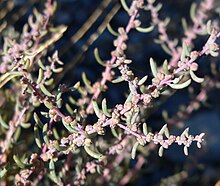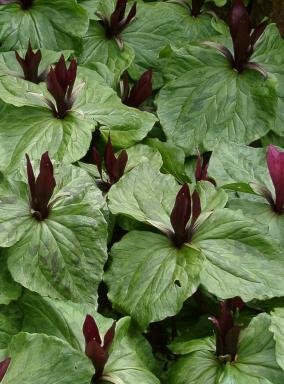
Trillium chloropetalum, also known as giant trillium, giant wakerobin, or common trillium, is a species of flowering plant in the family Melanthiaceae. It is endemic to the western U.S. state of California, being especially frequent in and around the San Francisco Bay Area.

Clintonia is a genus of flowering plants in the lily family Liliaceae. Plants of the genus are distributed across the temperate regions of North America and eastern Asia, in the mesic understory of deciduous or coniferous forests. The genus, first described by Constantine Samuel Rafinesque in 1818, was named for DeWitt Clinton (1769–1828), a naturalist and politician from the U.S. state of New York. For this reason, plants of the genus are commonly known as Clinton's lily. The common name bluebead refer to the distinctive fruit of members of the genus. Since fruit color varies somewhat across species, the common name bead lily is used as well.
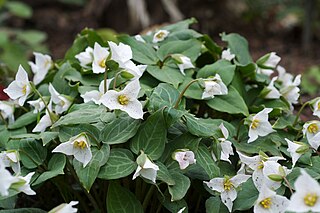
Pseudotrillium is a monotypic genus of flowering plant in the family Melanthiaceae. Its sole species, Pseudotrillium rivale, is commonly known as the brook wakerobin. It is endemic to the Siskiyou Mountains of southern Oregon and northern California. The Latin specific epithet rivale means “growing by streams”, with reference to a preferred habitat.
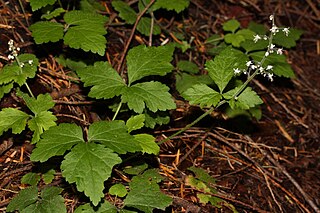
Tiarella trifoliata, the three-leaf foamflower, is a species of flowering plant in the family Saxifragaceae. The specific name trifoliata means "having three leaflets", a characteristic of two of the three recognized varieties. Also known as the laceflower or sugar-scoop, the species is found in shaded, moist woods in western North America.

Allium parishii is an uncommon species of wild onion known by the common name Parish's onion. It is native to the Mojave Desert and Sonoran Deserts of California and Arizona. It grows on open dry, rocky slopes at elevations of 900–1,400 m (3,000–4,600 ft).
Atriplex dioica is a species of saltbush known by the common names saline saltbush and halberdleaf orach. It is native to much of the United States and southern Canada, where it most often grows in saline and alkaline soils.

Orbexilum, commonly called leather-root, is a genus of flowering plants in the legume family (Fabaceae). They are native to North America, where they are found in the United States and Mexico, south to Chiapas.

Malacothrix incana is an uncommon species of flowering plant in the family Asteraceae known by the common name dunedelion. It is endemic to California, where it grows only in sand dunes on the beaches of the Channel Islands and isolated spots along the mainland coastline in San Luis Obispo and Santa Barbara Counties. The type specimen was collected in San Diego, but the plant no longer occurs there.

Salvia canescens, the hoary sage, is a herbaceous perennial that is endemic to the Caucasus mountains. The specific epithet, canescens, refers to the off-white hairs covering the leaves.
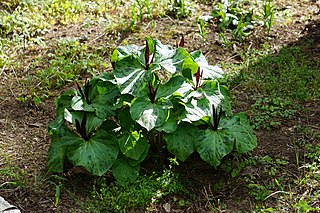
Trillium angustipetalum, with the common name is narrowpetal wakerobin, is a species of Trillium, plants which may be included within the Liliaceae or the newer family Melanthiaceae.

Suaeda vera, also known as shrubby sea-blite, shrubby seablight or in the USA sometimes as alkali seepweed, is a species of flowering plant in the family Amaranthaceae. It is a small shrub, with very variable appearance over its wide range. It is a halophyte, and occurs in arid and semi-arid saltflats, salt marshes and similar habitats.

Suaeda aegyptiaca is a species of succulent plant in the family Amaranthaceae, and salt-tolerant (halophyte) plant that is distributed in eastern North Africa, the Near East and West Asia.
Suaeda fruticosa is a species of flowering plant in the family Amaranthaceae. It is a small shrub, with very variable appearance over its wide range. It is a halophyte, and occurs in arid and semi-arid saltflats, salt marshes and similar habitats.

Chenopodiastrum is a genus of herbaceous flowering plants in the family Amaranthaceae. The genus was formally described in 2012. The 5 species occur in Eurasia, North Africa, and North America.

Scaevola plumieri is a species of plant in the family Goodeniaceae which grows on coastal dunes in the tropics and subtropics.
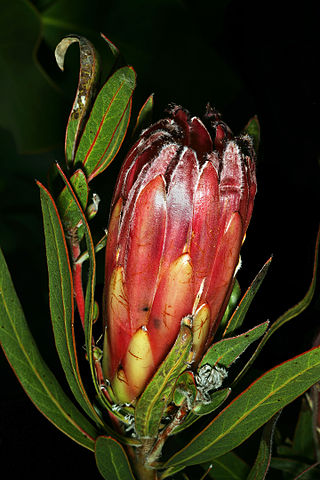
Protea burchellii, also known as Burchell's sugarbush, is a flowering shrub in the genus Protea, which is endemic to the southwestern Cape Region of South Africa.

Protea decurrens, also known as linear-leaf sugarbush, is a shrub of the genus Protea, in the Proteaceae family, which is endemic to the southwestern Cape Region of South Africa. It is a small shrub with a thick underground rootstock, this structure throwing up numerous leafy branches, upon the base of which clusters of flower heads may appear close to the ground. It is pollinated by rodents and grows in low-altitude fynbos or renosterveld.

Ilex umbellulata is an evergreen tree species related to holly, generally four to fifteen metres in height. It is found in Southeast Asia. This tree is most often found growing in forests.

Digitalis minor is a species of flowering plant in family Plantaginaceae, which has been called dwarf Spanish foxglove. It is a biennial or short-lived perennial species of foxglove which is endemic to the Balearic islands with large, pendulous, pink or purple flowers. Closely related to the common purple foxglove, it is best distinguished by its small fruits. It is one of the only foxgloves to grow in calciferous, alkaline soils.
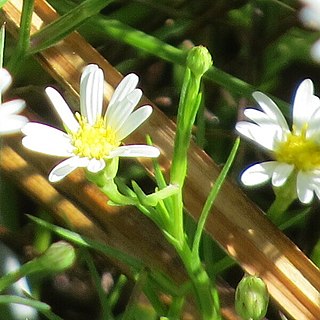
Symphyotrichum potosinum is a species of flowering plant in the family Asteraceae native to Mexico and the U.S. state of Arizona. Commonly known as Santa Rita Mountain aster, it is a perennial, herbaceous plant that may reach heights of 15 to 45 centimeters.
